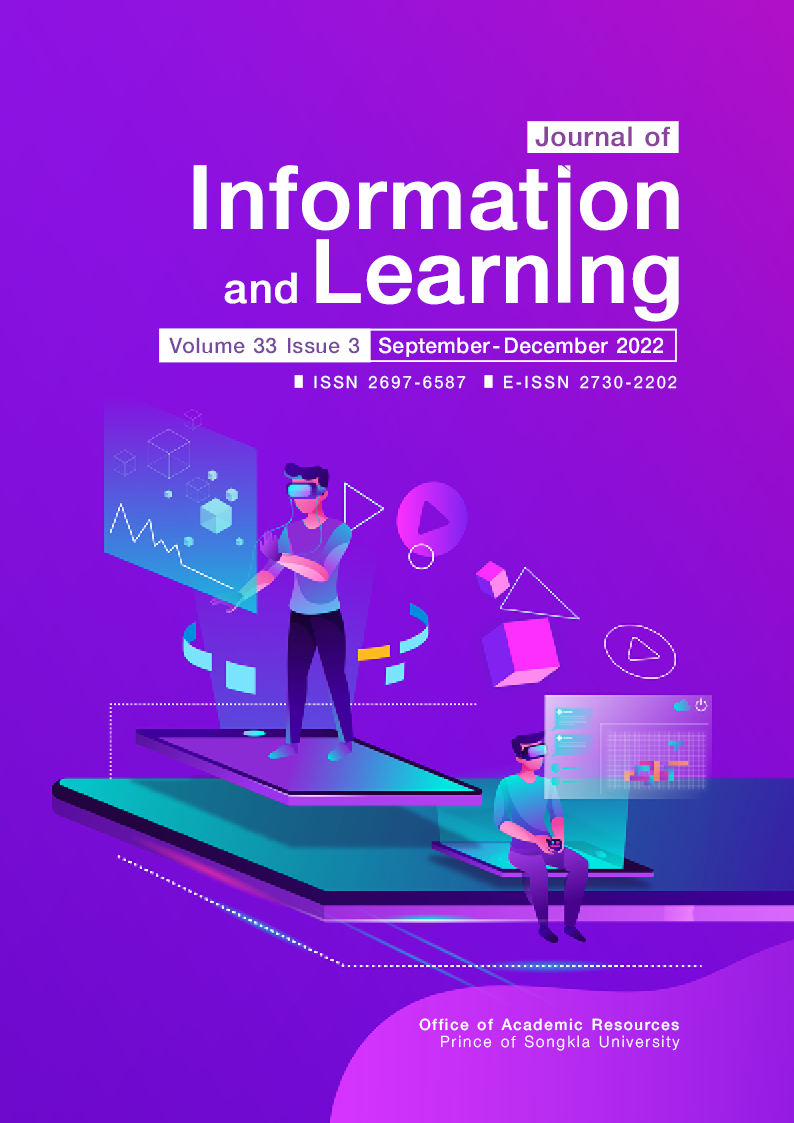Development of a Package of Storytelling Activities with Creative Drama to Enhance Relationship Skills of Primary School Students
Main Article Content
Abstract
The purposes of this study were 1) to develop a package of storytelling activities with creative drama to enhance relationship skills of primary school students and 2) to study the effects of using the activity package. The sample were 13 of Grade 2 students who studied at schools under the Office of the Private Education Commission in Lopburi in the second semester of the academic year 2021. Participants were selected by purposive sampling method. The data collection tools were a relationship skills assessment which is used with the assessment center simultaneously. The data were analyzed by using mean, standard deviation and Wilcoxon Sign rank-test.
The research findings showed that the activity package included eight activities which employed various storytelling techniques to make students understand a story and connect the idea and the point of view between themselves and the characters. Besides, creative drama was used so that students could have an interaction with friends by expressing feelings, making gestures and working with others in drama playing from the story to which they had listened. This activity package consisted of six key elements including concept and main feature of the activity package, the objective of the activity package, the activity in the package, the activity process, guidelines for using the activity package, and evaluation guidelines. After using the activity package, students had a higher mean post-test score on the relationship skills than pre-test at the .05 level of significance. When considered separately by the components of relationship skills, it was found that all of them had a higher mean score at the .05 level of significance, except teamwork.
Article Details

This work is licensed under a Creative Commons Attribution-NonCommercial-NoDerivatives 4.0 International License.
The Journal of Information and Learning is operated by the Office of Academic Resources, Prince of Songkla University. All articles published in the journal are protected by Thailand copyright law. This copyright covers the exclusive rights to share, reproduce and distribute the article, including in electronic forms, reprints, translations, photographic reproductions, or similar. Authors own copyrights in the works they have created as well as the Office of Academic Resources. The Journal reserves the right to edit the language of papers accepted for publication for clarity and correctness, as well as to make formal changes to ensure compliance with the journal's guidelines. All authors must take public responsibility for the content of their paper.
References
Azlina, S., Ahmad, M. F., & Abdullah, Z. (2021). Creative Drama as a teaching tool in the classroom. International Journal of Academic Research in Business and Social Sciences, 11(3), 1-6. http://dx.doi.org/10.6007/IJARBSS/v11-i3/8912
Brummelman, E., Nevicka, B., & O’Brien, J. M. (2021). Narcissism and leadership in children. Psychological Science, 32(3), 354-363. https://doi.org/10.1177/0956797620965536
Collaborative for Academic, Social and Emotional Learning [CASEL]. (2017). Sample teaching activities to support core competencies of social and emotional learning. Chicago, IL: Collaborative for Academic, Social and Emotional Learning. CASEL. https://www.casel.org/wp-content/ uploads/2017/08/Sample-Teaching-Activities-to-Support-Core-Competencies -8-20-17.pdf
Collaborative for Academic, Social and Emotional Learning [CASEL]. (2019). What is SEL?.Chicago, IL: Collaborative for Academic, Social and Emotional Learning. CASEL. https://casel.org/casel-sel-framework-11-2020/
Chungwiwaatthanaphon, P. (2004). La khǭn sāngsan samrap dek [Creative Drama for Children]. Institute of Academic Development.
Coie, J. D. (2004). The impact of negative social experiences on the development of antisocial behavior. In J. B. Kupersmidt & K. A. Dodge (Eds.), Children's peer relations: From development to intervention (243-267). American Psychological Association.https://doi.org/10.1037/10653-013
Gestwicki, C. (2014). Developmentally appropriate practice: Curriculum and development in early education (5th ed). Wardsworth.
Gordon, A. M., & Browne, K. W. (2014). Beginnings and beyond: Foundations in early childhood education. Wadsworth.
Guerra, V. S., Asher, S. R., & Derosier, M. E. (2004). Effect of children's perceived rejection on physical aggression. Journal of Abnormal Child Psychology, 32, 551-63. https://doi.org/10.1023/B:JACP.0000037783.88097.69.
Heinig, R. B., & Stillwell, L. (1981). Creative drama for the classroom teacher (2nd ed.). Prentice-Hall.
Hubbard, J. A. (2001). Emotion expression processes in children’s peer interaction: The role of peer rejection, aggression, and gender. Child Development, 72(5), 1426-1438. http://www.jstor.org/stable/3654396
Jiang, J., Zhang, Y., Ke, Y., Hawk, S. T., & Qiu, H. (2015). Can’t buy me friendship? Peer rejection and adolescent materialism: Implicit self-esteem as a mediator. Journal of Experimental Social Psychology, 58, 48-55. https://doi.org/10.1016/j.jesp.2015.01.001
Khammanee, T. (2012). Sātkānsǭn: Ong khwām rū phư̄a kān čhat kra būan kān rīan rū thī mī prasitthiphāp [Pedagogy: Knowledge for effective organization of learning processes]. Chulalongkorn University Press.
Konishi, C., & Wong, T. K. (2018). Relationships and school success: From a social-emotional learning perspective. In B. M. Blandian (Ed.), Health and Academic Achievement. IntechOpen. https://doi.org/10.5772/intechopen.75012
Kowtrakul, S. (2022). Čhitwitthayā kān sưksā [Educational Psychology] (14th ed.). Chulalongkorn University Press.
León-Jiménez, S., Villarejo-Carballido, B., López de Aguileta, G., & Puigvert, L. (2020). Propelling children’s empathy and friendship. Sustainability, 12(18), 72-88. https://doi.org/10.3390/su12187288
McCaslin, N. (1990). Creative dram in the classroom (5th ed). Longman. McCaslin, N. (2000). Creative drama in the classroom and beyond (7th ed). Pearson/Allyn and Bacon.
Panyajan, P., & Wisasa, C. (2001). Lao nithān yāng rai hai sanuk [How to tell stories in a fun way]. Amarin Baby & Kids.
RIDE. (2019). How can SEL skills be taught. IL: Rhode island department of education. https://www.ride.ri.gov/studentsfamilies/healthsafety/socialemotionallearning.aspx#18161726-4-relationship-skills
Saifah, Y. (2014). A transition between kindergarten and elementary grade classrooms: An important step of elementary school students. Journal of Education Studies, 42(3), 143-159. https://so02.tci-thaijo.org/index.php/EDUCU/article/view/26034/22077


